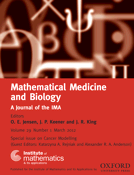-
Views
-
Cite
Cite
Stanley Gu, Gargi Chakraborty, Kyle Champley, Adam M. Alessio, Jonathan Claridge, Russell Rockne, Mark Muzi, Kenneth A. Krohn, Alexander M. Spence, Ellsworth C. Alvord, Alexander R. A. Anderson, Paul E. Kinahan, Kristin R. Swanson, Applying a patient-specific bio-mathematical model of glioma growth to develop virtual [18F]-FMISO-PET images, Mathematical Medicine and Biology: A Journal of the IMA, Volume 29, Issue 1, March 2012, Pages 31–48, https://doi.org/10.1093/imammb/dqr002
Close - Share Icon Share
Abstract
Glioblastoma multiforme (GBM) is a class of primary brain tumours characterized by their ability to rapidly proliferate and diffusely infiltrate surrounding brain tissue. The aggressive growth of GBM leads to the development of regions of low oxygenation (hypoxia), which can be clinically assessed through [18F]-fluoromisonidazole (FMISO) positron emission tomography (PET) imaging. Building upon the success of our previous mathematical modelling efforts, we have expanded our model to include the tumour microenvironment, specifically incorporating hypoxia, necrosis and angiogenesis. A pharmacokinetic model for the FMISO-PET tracer is applied at each spatial location throughout the brain and an analytical simulator for the image acquisition and reconstruction methods is applied to the resultant tracer activity map. The combination of our anatomical model with one for FMISO tracer dynamics and PET image reconstruction is able to produce a patient-specific virtual PET image that reproduces the image characteristics of the clinical PET scan as well as shows no statistical difference in the distribution of hypoxia within the tumour. This work establishes proof of principle for a link between anatomical (magnetic resonance image [MRI]) and molecular (PET) imaging on a patient-specific basis as well as address otherwise untenable questions in molecular imaging, such as determining the effect on tracer activity from cellular density. Although further investigation is necessary to establish the predicitve value of this technique, this unique tool provides a better dynamic understanding of the biological connection between anatomical changes seen on MRI and biochemical activity seen on PET of GBM in vivo.





